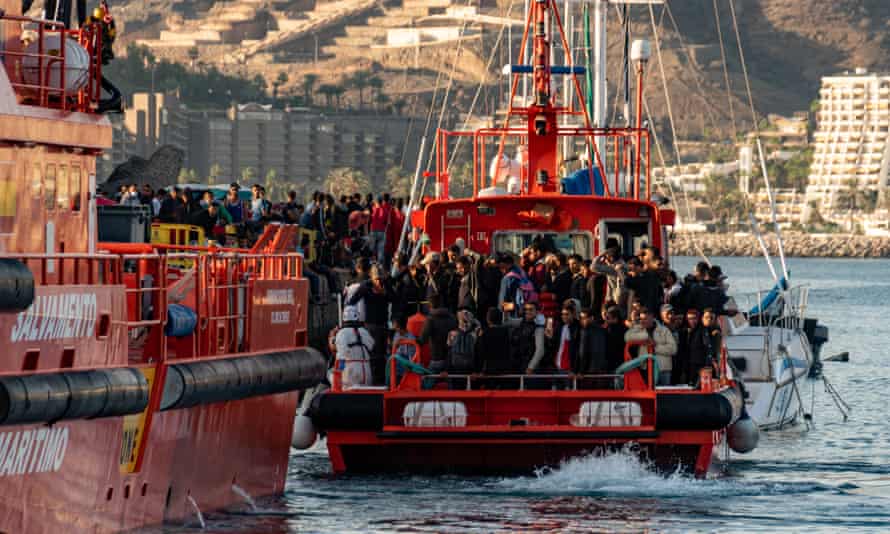
A crowded boat arrives at Arguineguín, Gran Canaria.
Photograph: Eduardo Robaina
Photograph: Eduardo Robaina
From The Guardian by Sam Jones
At 6.30am on Friday 28 May, three fishermen at work four miles off the southern coast of Tobago spotted a large white boat adrift on the dawn waters of the Caribbean.
As they drew closer, the trio saw the boat’s shape was far from local, and noticed a strong smell coming from inside it.
The body the fishermen glimpsed at the bow was enough to confirm their suspicions.
They called the coastguard who, unable to dispatch a vessel, asked them to tow the boat ashore at Belle Garden beach.
The sun was bright and the tide still low when William Nurse, an assistant commissioner with the Trinidad and Tobago police, arrived on the scene 90 minutes later.
What Nurse saw on the calm, sheltered beach at Belle Garden that morning was unlike anything he had witnessed in nearly four decades as a police officer.
“I’d never seen a boat come in with so many bodies.
I’d never seen anything like it,” says Nurse.
“Most of the bodies were concentrated in the middle of the boat.
There were two bodies to the rear of the boat and there were a few towards the bow.
I think one of those ones towards the bow was the last to die because there was still hair on the head.”
They called the coastguard who, unable to dispatch a vessel, asked them to tow the boat ashore at Belle Garden beach.
The sun was bright and the tide still low when William Nurse, an assistant commissioner with the Trinidad and Tobago police, arrived on the scene 90 minutes later.
What Nurse saw on the calm, sheltered beach at Belle Garden that morning was unlike anything he had witnessed in nearly four decades as a police officer.
“I’d never seen a boat come in with so many bodies.
I’d never seen anything like it,” says Nurse.
“Most of the bodies were concentrated in the middle of the boat.
There were two bodies to the rear of the boat and there were a few towards the bow.
I think one of those ones towards the bow was the last to die because there was still hair on the head.”
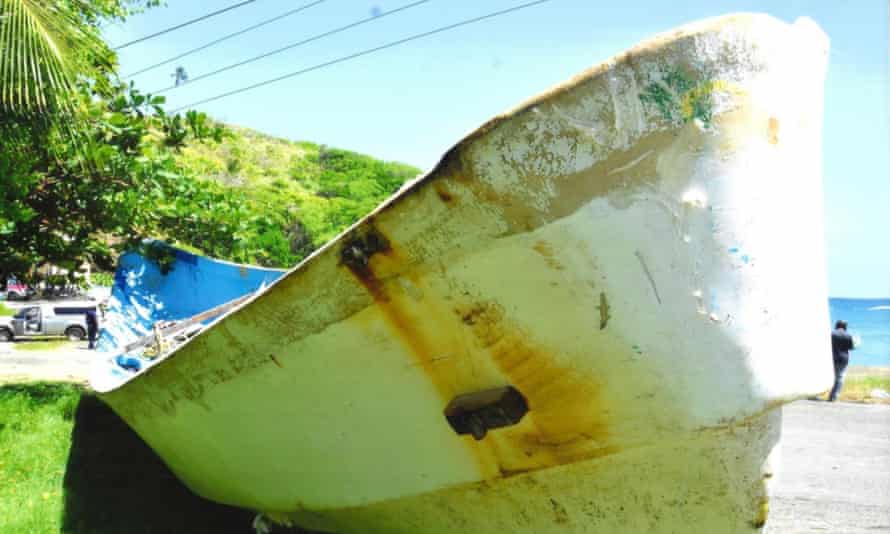
The migrant boat that was found floating off Tobago at the end of May, containing the bodies of 15 people.
Photograph: Courtesy of the Trinidad and Tobago Police Service
Thirteen badly decomposed corpses were recovered from the boat at first.
Then, after the water was drained from the bottom, officers found another body and some skeletal remains.
There were no lifejackets, no trace of food, and evidence that only a scant amount of fuel had been brought to run a 40hp outboard engine that was far too small to properly power the 42ft-long boat, which was registered in Mauritania.
Police found 1,000 Swiss francs, €50 and a number of mobile phones.
Those that weren’t irretrievably corroded were traced to Mauritania and Mali.
Even before postmortem examinations determined that 13 of the 15 bodies were those of African men, Nurse and his colleagues had begun to suspect that those aboard had not been trying to reach the Caribbean.
“We know that people from other African countries stop in Mauritania to get a boat with the hope of getting to Europe,” he said.
But those aboard the boat registered as AG231 – 15 people who died of hunger, thirst and exposure – appear to have overshot the continent by almost the entire width of the north Atlantic.
Six weeks later, Nurse got a phone call from Deputy Commissioner Rodney Adams of the Turks and Caicos police.
A boat carrying 15 bodies had been discovered drifting in the waters off Grand Turk.
“We suspect the same thing may have happened as it did with Tobago,” said Adams.
“We’ve had small boats coming across to us here in the Turks and Caicos from our neighbours 80 or 90 miles to the south in Haiti, but not from the other side of the Atlantic.”
The two boats and their 30 bodies are the exceptions to a deadly rule: most of those who die on the increasingly perilous Atlantic route from Africa to the Canary Islands are never found, their small boats, or pateras, swallowed by the waves.
In the midst of continuing instability and conflict, the climate crisis, border closures forced by the Covid pandemic and increased controls in some north African countries, the gangs that ferry migrants and refugees between Africa and Europe are making more and more use of the Atlantic route.
According to the International Organisation for Migration (IOM), 7,418 migrants and refugees have arrived by sea in the Canaries so far this year, while 250 have died in the attempt.
The fatalities are up on the same period last year – when 237 people died – and well above the total number of deaths in 2019, when 210 people lost their lives.
The IOM, however, believes that the true number of deaths is far higher because of the number of “invisible shipwrecks” – boats that vanish without trace.
A recent report from the Spanish migration NGO Caminando Fronteras(Walking Borders) suggested the true number could be almost eight times the IOM’s estimates.
Caminando Fronteras, which has spent 14 years tracking and helping to co-ordinate the rescues of people who come to grief en route to Spain from Africa, estimates that 1,922 people died or disappeared while trying to reach the Canaries by sea between January and the end of June this year.
By their calculations, the Atlantic route claimed 1,851 lives last year.
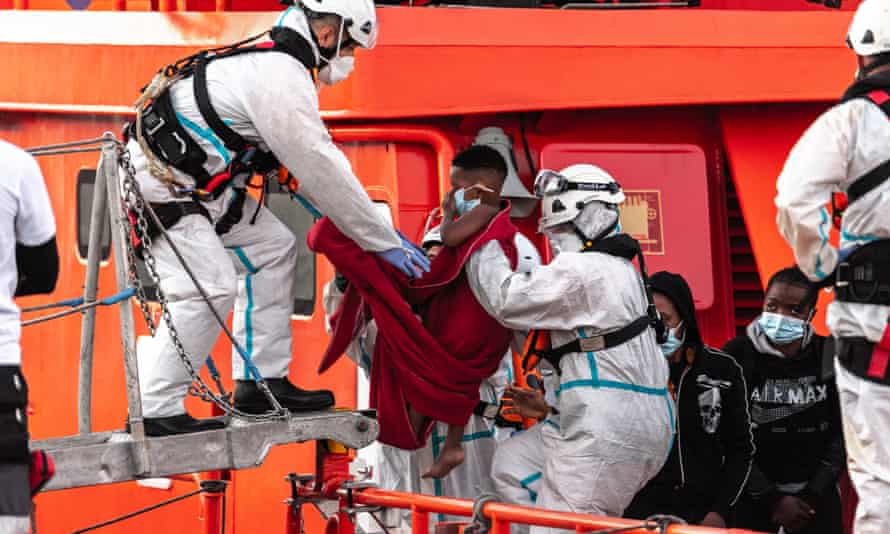
A rescued child is carried ashore at Arguineguín, on Gran Canaria, in March.
Photograph: Eduardo Robaina
Photograph: Eduardo Robaina
The port of Arinaga, half an hour’s drive south of Las Palmas, the capital of Gran Canaria, offers its own mute summary of what it going on across the Spanish archipelago and on the waves that lead to it.
Across its grey volcanic sands, under giant wind turbines and beneath the passenger planes descending towards the airport, lie the scores of pateras that have arrived on Gran Canaria over the past year and a half.
Ropes twist and snap in the fierce winds that whip across the port, and the names of the boats – Salma, Fatima, Nafai, Hayat among many others – are inscribed across the prows like the names on tombstones.
In their sandy, bleaching timbers lie glimpses of their voyages: empty water bottles; rusty tins of tuna and sardines; milk cartons with Arabic script; a single wellington boot; a pair of knock-off Adidas; spent batteries; a solitary sparkplug; and a very occasional lifejacket.
One of the pateras seems newly arrived, its hull still slicked with green, floor speckled with chickpeas and dates bloating in the sun, and the pungent smell of human faeces.
No part of the archipelago, however, speaks of all this quite as plainly as a small corner of San Lázaro cemetery.
Past the labyrinths of flower-decked niches and beyond the palms, the cactuses and the stones where Gran Canaria’s giant lizards charge up in the late afternoon sun, is a small grave ringed with stones.
The gold letters on a thick piece of white ribbon read: “Eléne Habiba Traore, forever in our hearts.”
Eléne, an 18-month-old old girl from Mali, had just reached the Gran Canaria port of Arguineguín with her mother and sister on the evening of 16 March this year when her heart stopped and she lost consciousness.
Red Cross workers managed to resuscitate her, but she died in hospital five days laterand was buried in the small Muslim section of San Lázaro, thanks to the efforts of the Federation of African Associations in the Canary Islands (FAAC), which helped arrange a plot and find an imam to officiate at her funeral.
Teodoro Bondyale, the secretary of the FAAC, refers to Eléne and countless others as murder victims because, he says, the conditions they face on the Atlantic route represent an almost certain death.
“What blame can that little girl from Mali possibly have?” he asks.
“She just had the bad luck to be born in this century, may she rest in peace.” If a decent burial is a basic right, adds Bondyale, “then so is the right not to have to flee from your country.
Where is the right to not have to migrate? That’s the basic question we have to ask ourselves: Why would a mother put her little girl into a small boat?”
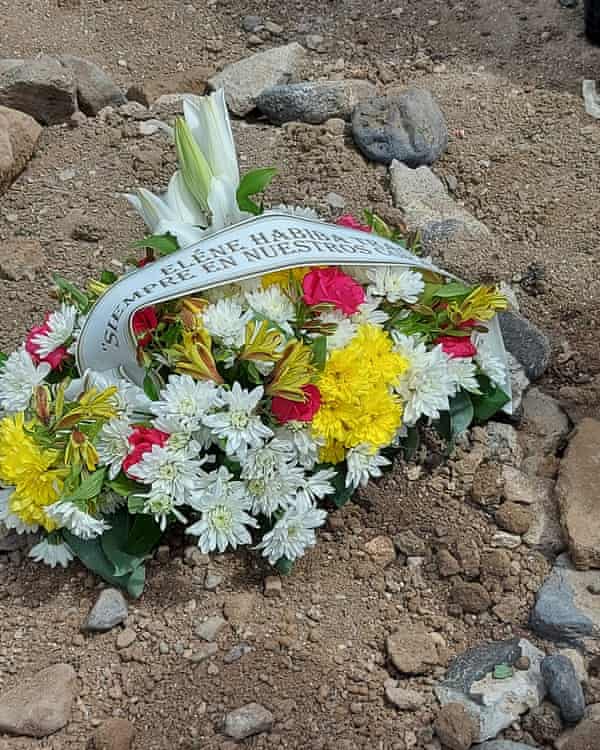
The grave of 18-month old Eléne from Mali in San Lázaro cemetery on Gran Canaria.
Photograph: Courtesy, Federation of African Associations of the Canary Islands
Photograph: Courtesy, Federation of African Associations of the Canary Islands
The high numbers of deaths and arrivals are stirring up a painful sense of deja vu on the archipelago.
Over the course of 2020 – but overwhelmingly in its final three months – 23,023 men, women and children arrived in the Canaries, pushing its unprepared and under-resourced reception infrastructure to the point of collapse.
If last year didn’t quite reach the levels of 2006 – the year of the “cayuco crisis”, when 36,000 people reached the Spanish archipelago in small and dangerous fishing boats - it dwarfed those of 2019, when arrivals stood at just 2,698.
Last autumn’s squalid images from the dock at Arguineguín, not to mention the Spanish government’s refusal to move people to the mainland, called into question the humanitarian credentials of the Socialist administration that won so many plaudits for taking in the 630 people aboard the rescue ship Aquarius in the early summer of 2018.
After visits from Human Rights Watch, Spain’s public ombudsman and others, the makeshift Arguineguín camp was dismantled and its occupants moved to hastily constructed facilities elsewhere on the island, where many reported similarly awful conditions.
Amnesty International has warned there is still time to avoid similarly “horrific scenes” in the Canaries this year, but says the Spanish government must act now to ensure that the most vulnerable arrivals are protected and transferred to the mainland.
Both Spain’s interior ministry and its migration ministry insist resources are in place to prevent a repetition of the failings of 2020.
On a recent visit to the Canaries the interior minister, Fernando Grande-Marlaska, said the archipelago now had “[reception] infrastructure that’s worthy of the strong and solid country that Spain is”, adding that arrivals to the Canaries were “moved elsewhere when necessary, and according to their vulnerability and to our analysis”.
The migration ministry, meanwhile, says the current situation bears little comparison with last year’s, not least because it has provided 7,000 reception places in six camps across the islands – of which 1,800 are currently occupied.
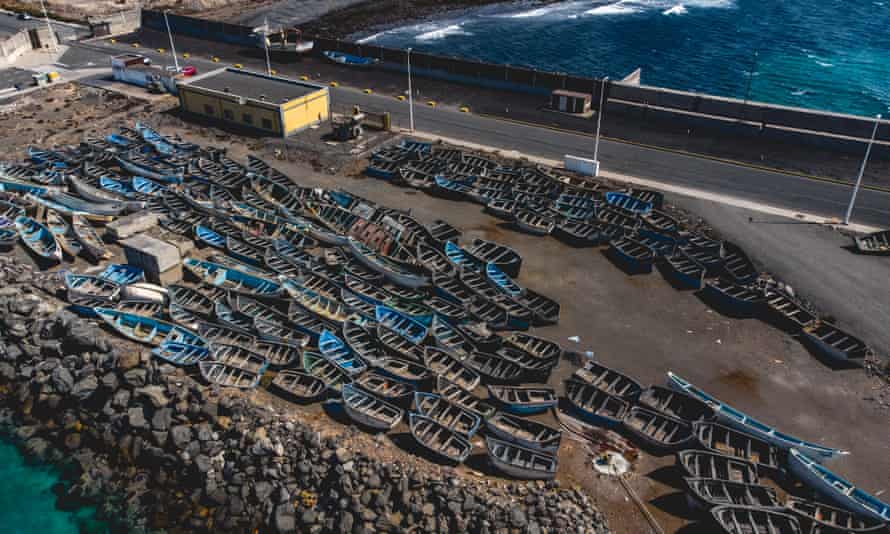 Recovered small boats on Gran Canaria.
Recovered small boats on Gran Canaria.Photograph: Eduardo Robaina/The Guardian
José Javier Sánchez Espinosa, director for social inclusion at the Spanish Red Cross, is also cautiously optimistic.
“Between January and 28 July las
t year, we helped 3,100 people,” he said.
“Over the same period this year, we’ve attended to 7,621 people.
So we’ve more than doubled the number we’re helping.
But the provision of reception and humanitarian assistance is much easier this year because there are more a lot more resources.”
Much, however, will depend on what happens after the summer.
The surge in last year’s numbers, driven mainly by people leaving Morocco amid the economic devastation wrought by coronavirus, only began in September.
Txema Santana, a migration adviser to the regional government of the Canaries, sees no reason why this year should be any better.
“The pandemic is the same – or worse – in both health and economic terms, and none of the situations people are leaving behind show symptoms of improving: you still have war in Mali; the conflicts in the Sahel are becoming more drawn out; things aren’t getting any better in Senegal; and you have the same repression in Guinea Conakry.” he said.
“And then we’ll see what happens with Moroccans, because they’re the ones who will determine the intensity of the rise.”
“Over the same period this year, we’ve attended to 7,621 people.
So we’ve more than doubled the number we’re helping.
But the provision of reception and humanitarian assistance is much easier this year because there are more a lot more resources.”
Much, however, will depend on what happens after the summer.
The surge in last year’s numbers, driven mainly by people leaving Morocco amid the economic devastation wrought by coronavirus, only began in September.
Txema Santana, a migration adviser to the regional government of the Canaries, sees no reason why this year should be any better.
“The pandemic is the same – or worse – in both health and economic terms, and none of the situations people are leaving behind show symptoms of improving: you still have war in Mali; the conflicts in the Sahel are becoming more drawn out; things aren’t getting any better in Senegal; and you have the same repression in Guinea Conakry.” he said.
“And then we’ll see what happens with Moroccans, because they’re the ones who will determine the intensity of the rise.”
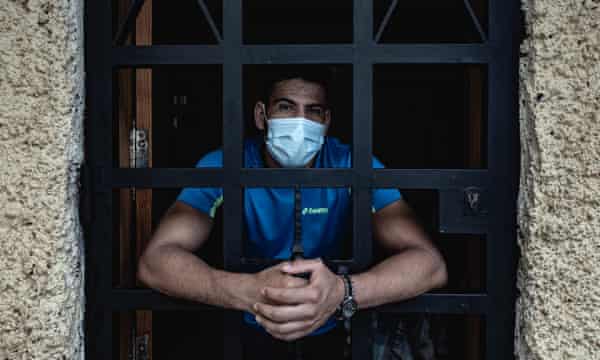
A migrant helper at the church in Las Reyohas, Gran Canaria.
Photograph: Eduardo Robaina/The Guardian
Photograph: Eduardo Robaina/The Guardian
Santana and others say there must be no repeat of the interior ministry’s airport blockade, which stopped new arrivals with valid passports from flying to mainland Spain and was only overturned by the courts in mid-April.
“If people can’t be moved to other parts of Spain, then, yes, there could be more problems here in the Canaries,” said Santana.
“But even [the transfers] don’t mean there aren’t people who are having to live on the street because they’ve got nowhere to go.
There are still people in camps who’ve been here for six months.”
José Antonio Benítez, a Claretian missionary and the parish priest of Our Lady of Peace in Las Rehoyas, one of Gran Canaria’s most deprived neighbourhoods, knows all too well what happens when the system begins to buckle and small NGOs and community groups have to step in.
Last year, he witnessed the toll the crisis was taking on both locals and the new arrivals.
“People didn’t stop arriving and the response from the authorities was silence, inaction and closing the borders,” he said.
“There was no way to get out and people ended up staying here.
That led to a lot of unease within the Canaries.
People were tired of the situation, and there were the fears being whipped up by certain political groups.
Then you had the pandemic, which left the islands’ economic, employment and health situation in an awful state.”
Rumours and fake news – much of it spread by the far right – led to protests and outbreaks of xenophobic violence.
Towards the end of 2020, stories that migrants were raping women brought people on to the streets of Las Rehoyas with sticks and knives.
Today, the neighbourhood is quieter.
A handful of young migrants sit in a room off the parish centre kitchen and chat in their newly acquired Spanish as they make sandwiches for the church’s soup kitchen, which feeds up to 60 each day – most of them native Canary islanders.
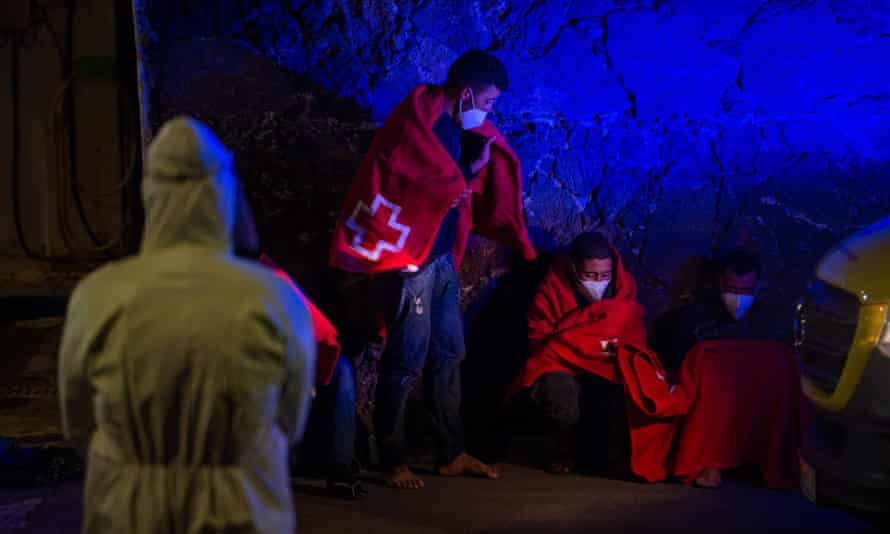 Three men recover in Arrieta on Lanzarote last month after being rescued from a small boat.
Three men recover in Arrieta on Lanzarote last month after being rescued from a small boat.Photograph: Javier Fuentes/EPA
Babacar Ndiaye left his home in Senegal in October last year and endured a seven-day voyage in a small boat with 50 others.
After arriving at Arguineguín, where he spent 10 days on the dock, he was put in a hotel for four months and wound up on the streets until a woman from a local NGO brought him to the church.
“I was a fisherman back in Senegal but the fishing just isn’t what is once was – you work a lot and earn very little,” said the 30-year-old.
“So I decided to leave my wife and two daughters behind and come to Spain.
It was pure chance that we made it.”
Ndiaye is desperate to work – “maybe in a restaurant or as a driver; anything” – but can’t until his papers come through.
For now, he bides his time, watches his two young daughters grow up in video calls, and shrugs off the hatred he sometimes receives.
“There’s one woman who just can’t bear seeing black people and who calls us trash and other horrible things, but that doesn’t bother me,” he said.
“Anyway, I wouldn’t answer her back because she’s an older woman like my mother.
And there are also some really good people here.”
Hassan Hadda, another sandwich maker, has been in the Canaries since April 2017 and is still waiting to be regularised.
Like Ndiaye, the 25-year-old Moroccan wants to find work so he can send money home to his parents and six younger siblings.
And, like Ndiaye, he will never forget his journey to the archipelago from Dakhla in Western Sahara.
“People who’ve never made that journey will never understand it,” he says.
“It took three days and there were 28 people in a 5 metre-long boat that was a metre-and-a-half wide.
We were packed liked sardines.
I’d always dreamed of getting to Europe since I was a kid.
It didn’t matter where it was – France, Spain or anywhere else – I felt I’d never have a future if I stayed where there’s no work and no human rights.
That is why I risked my life.”
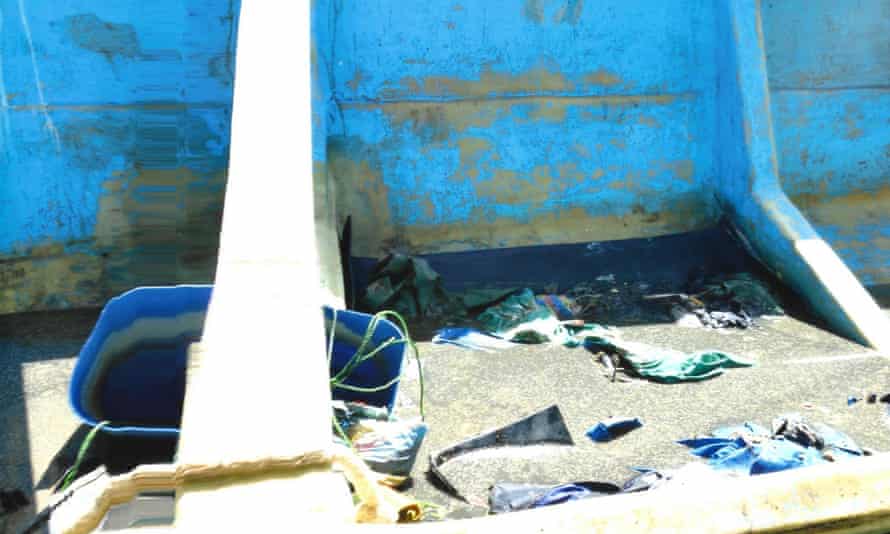
The interior of the migrant boat that was found floating off Tobago.
Photograph: Courtesy of the Trinidad and Tobago Police Service
Photograph: Courtesy of the Trinidad and Tobago Police Service
Across the Atlantic, William Nurse is hopeful that fingerprints taken from three of the bodies will help identify at least some of those who drifted to the coast of Tobago.
For now, though, they lie, unnamed, but probably not unmourned, in a morgue in Port of Spain.
The ugly historical echoes of their fatal, 3,500-mile voyage are not lost on the assistant commissioner of police.
“I never thought that a region from which my foreparents were brought would produce a boat with dead people trying to reach Europe but which ended up in the Caribbean,” he said.
“They were trying to flee something – I don’t know what it was – but everybody’s looking for a better life.”
Links :

No comments:
Post a Comment